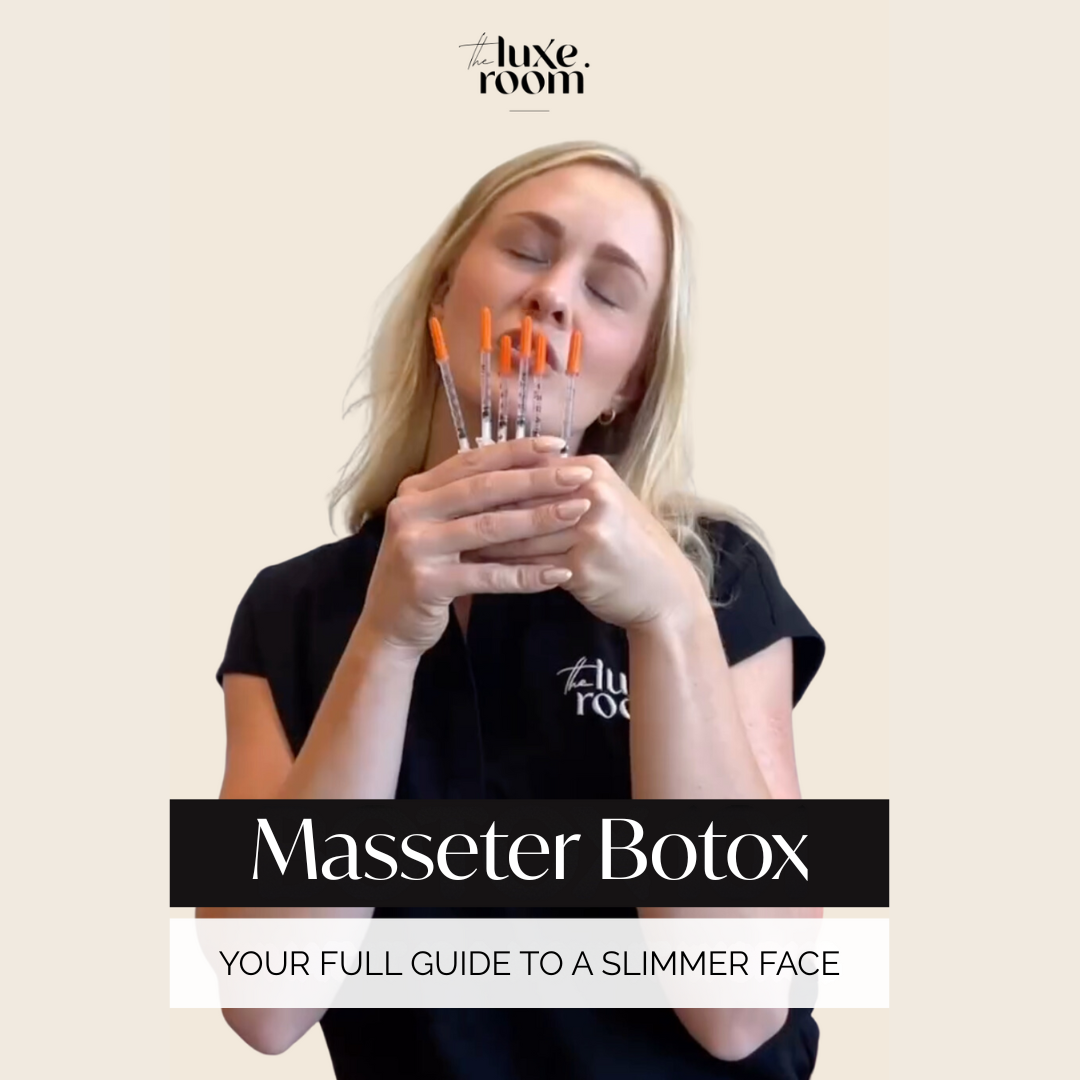Your Guide to Masseter Botox for Face Slimming
Not loving the shape of your lower face? Think it’s too wide or boxy or even chubby – despite you being at your goal weight? You’re not imagining it, and the culprit is often the masseter – a strong, overworked muscle that can bulk up your jawline more than you realize.
It’s not something most people think about until they hear the words masseter Botox. Here’s everything you need to know about what it is, how it works, and why it might be the face-slimming solution you’ve been looking for.
What Is Masseter Botox for Facial Slimming?
First things first, a quick anatomy lesson. The masseter muscle is one of the strongest muscles in the human body. Located at the back of the jaw, near the mandible’s angle, it’s responsible for lifting your jaw when clenching, chewing, and speaking.
Because it’s so strong, the masseter is also quite large. Like any muscle, too much activity can make it grow in size, which can cause a whole array of problems – from cosmetic issues to headaches and tooth wear.

But not all masseter hypertrophy is caused by clenching. Some people have naturally stronger and larger masseters and square faces, making them predisposed to muscle enlargement in that area.
Other factors that can enlarge the masseter muscle include teeth grinding, jaw clenching from stress, frequent gum chewing, and tension from muscle or dental imbalances.
Masseter Botox isn’t for everyone (because not everyone will have overactive muscles), but it works like a charm at relaxing this muscle just the right amount that it relieves tension and subtly changes your jaw shape – from boxy to more rounded and slimmed down. However, an assessment by an experienced practitioner will help determine if this treatment would be beneficial for you. As an example, if your jawline is wide due to a side mandible rather than a large masseter muscle, Botox or other neuromodulators may not reduce the jaw size.
Botox is a brand of neuromodulator used for temporarily relaxing facial muscles to smooth dynamic wrinkles caused by expression and relax overactive muscles that cause unwanted effects. Other name brands include Jeuveau, Dysport, Xeomin, and Daxxify, and they all follow the same principle. Relfydess is another brand of neuromodulator that is currently in Phase III FDA trials and is already approved in other countries, such as Australia.
When injected strategically into the masseter muscle, Botox relaxes and weakens part of the muscle, leading to less bulge and a slimmer appearance. While it hasn’t been FDA-approved for this specific indication (aka ‘off-label’ for jawline slimming), Botox is commonly used off-label to treat various conditions created or worsened by the masseter, and many studies have proven that its results are safe and predictable when in the hands of a qualified practitioner.
How Does Masseter Botox Work to Slim Your Jawline?
Once injected, Botox gets to work inside the masseter muscles by relaxing them. You may start to notice less bulk several months from the first session. As the treatment repeats over time – similar to when you stop going to the gym – your masseters will start to lose mass, leading to a narrower jawline.
This doesn’t mean your muscles are wasting away; they’re just losing that extra “oomph” they’ve been working so hard on. Here’s a timeline of typical results that most patients experience:
- Initial Slimming: Can begin around 2 – 4 months after your first treatment. This is when many patients start to notice a softer, more tapered jawline.
- Peak Contour: Typically reached around 6 months post-treatment. Most patients receive their second session at the 3 – 4 month mark, which enhances and extends results, leading to this peak contour.
- Subtle reshaping over multiple sessions: Each treatment builds on the last, gradually refining your jawline.
Just like with other Botox treatments, Many patients find they need fewer units over time or they can extend out the timeline of their treatments, as the muscle adapts and maintains a slimmer profile.
How Long Will Your Results Last?
Masseter Botox results typically last around 3 to 6 months, though this can vary based on factors like metabolism, baseline muscle strength, gender, and underlying medical conditions. If you have genetically stronger masseters to begin with, you may require a stronger dose.
To maintain your results, it’s generally recommended to schedule repeat treatments every 3 to 6 months. Different patient’s intervals can vary, but you shouldn’t wait until Botox effects wear off completely.
If you decide to stop treatments, the masseter muscles may gradually return to their original size and strength, and the jawline will typically return to its previous look. Some patients report clenching or grinding in the early stages of the masseter muscle regaining its baseline strength, so this is something to note.

Who Injects Masseter Botox and What Happens in a Session?
Who handles your neurotoxin injections depends on whether it’s a cosmetic concern or a medical concern. Patients typically see a cosmetic doctor or licensed injector trained in masseter Botox for aesthetic face slimming. If the concern is medical, patients will typically visit a dentist, oral surgeon, or another type of medical doctor for bruxism/TMJ relief and tension headaches.
It’s absolutely crucial that you see a skilled injector when receiving masseter Botox. The masseter sits in a sensitive area, in relation to the parotid (main salivary gland) and risorius muscle (that controls the corners of your mouth when you smile). Injecting neurotoxin too close to the cheek or too high can cause some unpleasant, though temporary, side effects.
As with all Botox treatments, a session is quick and relatively pain-free. Here’s a quick walkthrough of what to expect:
- Consultation: Your provider will examine your jawline/masseter muscles, discuss your goals and assess if you’re a good candidate for the procedure.
- Marking: The injection sites are marked for precision, targeting the lower half of the masseters. Some experienced injectors may not require marking as they work on constant palpation and assessment during treatment, so don’t worry if this is not part of the process.
- Numbing: A numbing cream may be applied to minimize discomfort, but is typically not needed.
- Injections: Botox is injected in target areas with just a few quick pokes. , deep into the masseter muscles.
- Aftercare: Minimal downtime; you can resume normal activities immediately after.
Typical dosage starts at 20 units per side for most females, and can go up to 25 – 40 units per side based on muscle size, gender, and goals. For first-timers, it’s best to start slowly to factor in diffusion and how you’ll react to the neurotoxin. You may need a follow-up in 2-3 weeks to assess efficacy and determine if a larger dose is needed.
Masseter Botox Aftercare: What to Keep in Mind
The main goal after your Botox session is to help the neurotoxin stay exactly where it was placed. For the first 24-48 hours, it’s all about avoiding anything that could lead to migration of the Botox to another muscle.
Stick to soft foods and keep jaw movement gentle. Try not to overdo it with talking, laughing, or chewing – just let the area relax.
Avoid facial massages, intense facial workouts, or makeup application for the day. Steer clear of alcohol for 48 hours before and after, since it can increase the risk of bruising (even after treatment).
It’s also best to stay upright for at least 4 to 6 hours post-treatment. That means no lying down, no long naps, and no bending over for extended periods of time.
Skip workouts, hot yoga, and saunas for 24 hours – anything that makes you sweat or increases blood flow to the face can interfere with results and bruising.
Lastly, it’s recommended to hold off on facials, gua sha, lasers, or skin tools for a few days after treatment. Give your face some quiet time to let the Botox settle in smoothly.
It’s normal for your jaw to feel a bit sore for a few days after treatment, especially when chewing gum or eating food that requires strong chewing (such as steak). This is because the Botox is working at relaxing your muscle, meaning intense chewing can be exhausting. This sensation typically subsides after a few days or a few weeks.
Benefits Beyond Slimming: Bruxism, TMJ, and Headache Relief
Let’s talk about some extra perks that some patients report after getting masseter Botox. If you’ve been grinding your enamel like it’s your job, you’ll likely notice your bruxism subside within 1–2 weeks – along with those annoying morning headaches as your master muscles will be weaker after the effects of Botox settle in. Your teeth will thank you, and your dental work may hold up way better.
Though we are treating for facial slimming results here in the aesthetic world, Botox has been reported to improve TMJ pain for some patients. The masseter works alongside the temporalis and pterygoid muscles, forming an intricate network that helps your jaw move and rotate. When those muscles get out of sync, the TMJ (your jaw joints) can start acting up with symptoms like pain, clicking or locking.
If you have TMJ issues, it’s best to seek care from a dental or medical doctor before jumping into Botox, since it’s a complex condition that needs comprehensive treatment.

Masseter Botox Side Effects: What You Might Notice
Botox in the masseter is a medical procedure, and like any treatment, it comes with risks and side effects. Most are mild and related to the injection itself – like bruising or tenderness. Others have more to do with how the muscle responds over time.
Common:
- Mild chewing weakness (around 30% of patients notice this)
- Bruising at the injection site (~2.5%)
- Temporary headaches (~0.6%)
Less common:
- Large bruises or hematomas
- Smile asymmetry or drooling if the injection is placed too far forward/close to the cheek
- Paradoxical bulging/hyperplasia – where parts of the muscle shrink unevenly, giving a slightly wavy jawline. This can be corrected by an easy follow-up injection of Botox by your practitioner.
- Hollow pre-auricular area or early jowling if the muscle shrinks too much and no longer supports the tissue around it. This is typically corrected by ceasing the masseter muscle injections by allowing the muscle to rebound to it’s original shape and size.
Rare:
- Dry mouth (if the parotid gland is accidentally affected, though this typically requires a very high dose in this gland)
- Very subtle speech changes
The most common effect is mild chewing fatigue, especially with harder foods. This usually fades quickly, as the rest of your masseter and nearby muscles adjust and take over.
Smile asymmetry is another one to watch out for. It’s why your injector needs to place Botox carefully – not too far medial (forward) or superficial, and not unevenly from side to side (unless they’re correcting an existing imbalance). The risorius muscle, which helps lift the corners of your mouth, sits right next to the masseter and is easy to hit if someone isn’t familiar with facial anatomy.
Most patients are quite pleased with their results. If you don’t like your results, rest assured that effects are temporary and should wear off within a few months.
Masseter Botox vs. Buccal Fat Removal
If you’re looking to slim your face, you’ve probably come across buccal fat removal too. But here’s the thing: they’re very different treatments – and the results are not interchangeable.
Buccal fat removal is surgical. It consists of surgically removing the buccal fat pads in your cheeks to create a more contoured, chiseled look. It can be great for some people, but it’s permanent. In many cases, it can actually age the face long-term, especially if you already have a naturally lean or angular look. Therefore, it’s important to consult with a board-certified facial plastic surgeon when considering buccal fat removal as an option.
Masseter Botox, on the other hand, works by gently slimming the lower face through the relaxation of a hypertrophied (or enlarged) jaw muscle. It doesn’t remove fat. It softens the width of the jaw muscle – which may make your cheekbones pop without making you look gaunt. In fact, keeping a bit of roundness in the cheeks tends to look fresher, younger, and more balanced overall.
Treatments to Pair with Masseter Botox
Masseter Botox does the heavy lifting when it comes to slimming the lower face – but pairing it with the right cosmetic treatments can take you to the next level. If you’re going for lift, balance, or just want to keep things tight as your jaw contour softens, these are worth considering and discussing with your practitioner:
- Dermal fillers
Once your jawline slims down, the rest of your face might benefit from a little rebalancing – especially if the cheeks or chin start to feel less defined in comparison. Dermal fillers can add back subtle structure, contour the midface, and keep your features looking harmonious. - RF (Radiofrequency) Microneedling
When the muscle shrinks, some patients may notice mild laxity of the skin in the lower face. While not everyone gets jowling, if you’re prone to this or already seeing early signs, skin tightening through can help keep things firm and lifted. - Sculptra (Plla) or Radiesse (CaHa)
These are great options to discuss with your practitioner if slimming the jaw makes the midface feel a little flat or tired. Sculptra builds collagen over time, adding subtle volume and support – especially in the cheeks or temples. Radiesse is another option for collagen stimulation that can also double as a dermal filler, giving instant and long-term benefits.
FAQs on Masseter Botox
Can masseter Botox subtly reshape my lower face over time?
Yes – but it’s not a one-and-done. The first time you get Botox in your masseters, you’ll see the muscle start to relax after a few weeks. But the real magic happens after multiple sessions, as the muscle mass gradually decreases from weakening. That’s when you’ll notice a slimmer, more rounded face and a narrower jawline.
Will treating just one side throw off my facial balance?
Not always, but there’s more to consider when treating asymmetry with this procedure. If your asymmetry is caused by one overactive masseter, treating just that side can actually restore balance – which is the goal. That said, most people are treated evenly unless there’s a clear imbalance. An unwanted side effect of treating the masseters for asymmetry is the result of an uneven bite, leading to dental issues. Trust your injector’s eye and experience.
Does masseter Botox make cheekbones look more prominent?
It can. If you already have defined cheekbones, relaxing the masseters can help them stand out more. But in some cases, if the masseter was giving structure to the lower face, slimming it too much can lead to a slightly sunken or hollowed look. It really depends on your facial anatomy and a skilled injector will take that into account.
Could it affect my chewing strength or speech?
Mild chewing fatigue is normal. We’re intentionally relaxing this muscle, so things like chewing steak or tough bread might feel like more work, especially at first. But other nearby muscles will step up, and many people find that eating softer food, or more mindfully actually helps.
Ready for a Slimmed Jawline?
Call us or click below to book your personalized masseter Botox consultation at The Luxe Room. Available in Denver, Boulder, and Fort Collins. Let’s find the contour that feels like you.
Sources
- Fortes, J., Pontes, F., Santos, A., et al. (2014). Lower facial remodeling with botulinum toxin type A for the treatment of masseter hypertrophy. Anais Brasileiros de Dermatologia, 89(6), 970–977. Retrieved from https://www.scielo.br/j/abd/a/RfBqLvYw35xjdBFgfmPtFHS/?lang=en&format=html
- Zhao, Y., Li, S., Chen, H., et al. (2020). Complication rates of masseter muscle botulinum toxin injections: Analysis of 2,036 cases. Journal of Cosmetic Dermatology, 19(11), 2966–2971. Retrieved from https://onlinelibrary.wiley.com/doi/10.1111/jocd.12473
- Yates, C., & Yen, Y. (2020). Refining toxin treatment in the masseters. In Botulinum Toxin in Aesthetic Medicine (2nd ed., Chapter 18). Taylor & Francis. Retrieved from https://www.taylorfrancis.com/chapters/edit/10.1201/9781003008132-18/refining-toxin-treatment-masseters-yates-yen-yu-chao



